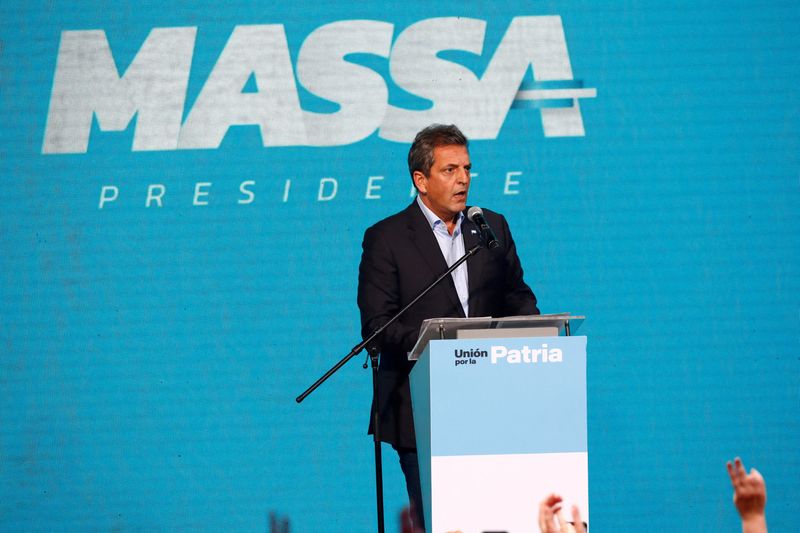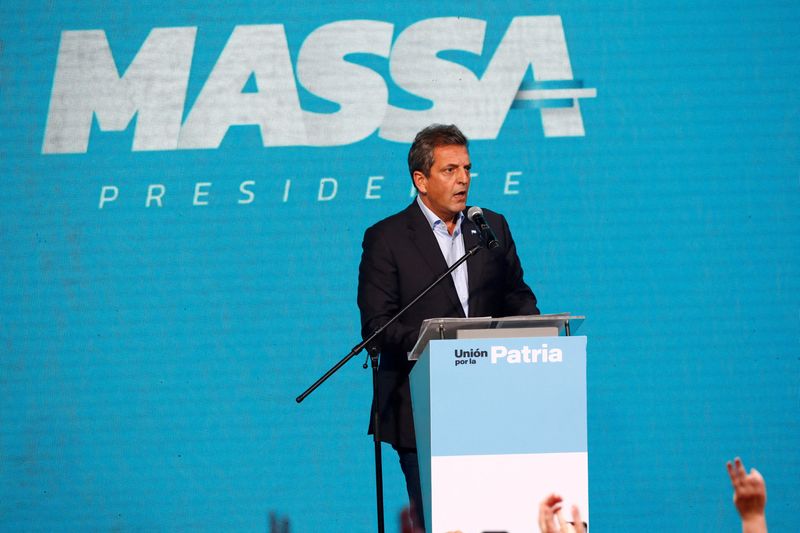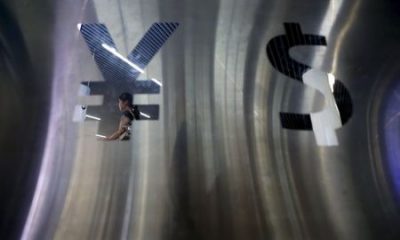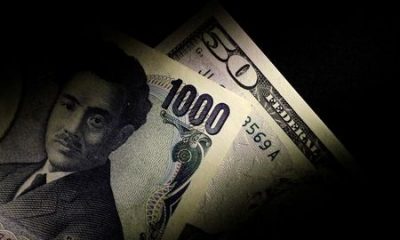Economy
Analysis-How Argentina’s Massa pulled off election upset with tax cuts and bus fares


© Reuters. FILE PHOTO: Argentina’s presidential candidate Sergio Massa addresses supporters, as he reacts to the results of the presidential election, in Buenos Aires, Argentina October 22, 2023. REUTERS/Mariana Nedelcu/File Photo
By Anna-Catherine Brigida
BUENOS AIRES (Reuters) – Argentine Economy Minister Sergio Massa’s political escape act – winning a first round general election despite overseeing the country’s worst economic crisis in decades – was built on tax cuts, and voter concerns of higher bus fares and medical bills.
On Sunday, the centrist Peronist economy chief scored some 37% of the vote ahead of far-right libertarian Javier Milei who received 30%, a surprise reversal of pre-vote expectations giving him the momentum into a Nov. 19 run-off.
Massa’s win underscores how he managed to successfully play up fears that Milei’s radical proposals to fix a broken economy could make things worse for the millions who are heavily reliant on state subsidies, despite voter anger at the government.
In the week running up to the vote commuters were shown two ticket prices on trains and buses with a low “Massa price” or far higher prices under his rivals without subsidies. Local media reported similar though more informal campaigns in some hospitals, and the energy secretary warned the price of subsidized gas could double.
Massa also expanded income tax exemptions to all workers earlier this month, a popular move though at a significant cost to already depleted state funds and fiscal targets agreed with major creditor the International Monetary Fund (IMF).
Milei, meanwhile, has pledged to “chainsaw” the economic status quo and privatize many state entities, gaining a strong backing by voters fed up with years of economic mismanagement, but also spooking some people with his often violent rhetoric toward his critics.
“For me it was a matter of time before people realized that Milei’s proposals made no sense,” said Amparo Anzaldi, 20, a student in Buenos Aires. “It is not going to be easy to take away our education or public health.”
‘CHAINSAWING’ THE WELFARE STATE?
Milei had talked about being in favor of privatization of state entities and Chile’s public-private model, a sharp shift from the Peronist’s social welfare that creates a safety net for the least well-off but has drained state coffers.
“A lot of Argentines have a lot to lose from the dismantling of the welfare state,” said Benjamin Gedan, director of the Wilson Center’s Argentina Project, adding Milei’s campaign appearances wielding a chainsaw to illustrate his plans to trim back the size of the state may have backfired.
“At the other end of the chainsaw he totes at rallies are the pocketbooks of millions of Argentines,” he added.
Massa though does bear major political baggage from the government’s economic failures over the years, even if he is a more of a centrist and not closely allied to the Peronist movement’s leftist icon Cristina Fernandez de Kirchner.
Ana Monclus, a 20-year-old student, meanwhile said she was skeptical of the governing party that had led the country during its current economic predicament, with multiple exchange rates, rising debts and a looming recession.
“The truth is that I can’t believe that people continue to elect this government. Years of corruption, the dollar going to hell, inflation to hell and they vote for the same people who are there now,” she told Reuters.
Economy
Russian central bank says it needs months to make sure CPI falling before rate cuts -RBC


© Reuters. Russian Central Bank Governor Elvira Nabiullina attends a news conference in Moscow, Russia June 14, 2019. REUTERS/Shamil Zhumatov/File Photo
MOSCOW (Reuters) – Russia’s central bank will need two to three months to make sure that inflation is steadily declining before taking any decision on interest rate cuts, the bank’s governor Elvira Nabiullina told RBC media on Sunday.
The central bank raised its key interest rate by 100 basis points to 16% earlier in December, hiking for the fifth consecutive meeting in response to stubborn inflation, and suggested that its tightening cycle was nearly over.
Nabiullina said it was not yet clear when exactly the regulator would start cutting rates, however.
“We really need to make sure that inflation is steadily decreasing, that these are not one-off factors that can affect the rate of price growth in a particular month,” she said.
Nabiullina said the bank was taking into account a wide range of indicators but primarily those that “characterize the stability of inflation”.
“This will take two or three months or more – it depends on how much the wide range of indicators that characterize sustainable inflation declines,” she said.
The bank will next convene to set its benchmark rate on Feb. 16.
The governor also said the bank should have started monetary policy tightening earlier than in July, when it embarked on the rate-hiking cycle.
Economy
China identifies second set of projects in $140 billion spending plan


© Reuters. FILE PHOTO: Workers walk past an under-construction area with completed office towers in the background, in Shenzhen’s Qianhai new district, Guangdong province, China August 25, 2023. REUTERS/David Kirton/File Photo
SHANGHAI (Reuters) – China’s top planning body said on Saturday it had identified a second batch of public investment projects, including flood control and disaster relief programmes, under a bond issuance and investment plan announced in October to boost the economy.
With the latest tranche, China has now earmarked more than 800 billion yuan of its 1 trillion yuan ($140 billion) in additional government bond issuance in the fourth quarter, as it focuses on fiscal steps to shore up the flagging economy.
The National Development and Reform Commission (NDRC) said in a statement on Saturday it had identified 9,600 projects with planned investment of more than 560 billion yuan.
China’s economy, the world’s second largest, is struggling to regain its footing post-COVID-19 as policymakers grapple with tepid consumer demand, weak exports, falling foreign investment and a deepening real estate crisis.
The 1 trillion yuan in additional bond issuance will widen China’s 2023 budget deficit ratio to around 3.8 percent from 3 percent, the state-run Xinhua news agency has said.
“Construction of the projects will improve China’s flood control system, emergency response mechanism and disaster relief capabilities, and better protect people’s lives and property, so it is very significant,” the NDRC said.
The agency said it will coordinate with other government bodies to make sure that funds are allocated speedily for investment and that high standards of quality are maintained in project construction.
($1 = 7.1315 renminbi)
Economy
Russian central bank says it needs months to make sure CPI falling before rate cuts -RBC


© Reuters. Russian Central Bank Governor Elvira Nabiullina attends a news conference in Moscow, Russia June 14, 2019. REUTERS/Shamil Zhumatov/File Photo
MOSCOW (Reuters) – Russia’s central bank will need two to three months to make sure that inflation is steadily declining before taking any decision on interest rate cuts, the bank’s governor Elvira Nabiullina told RBC media on Sunday.
The central bank raised its key interest rate by 100 basis points to 16% earlier in December, hiking for the fifth consecutive meeting in response to stubborn inflation, and suggested that its tightening cycle was nearly over.
Nabiullina said it was not yet clear when exactly the regulator would start cutting rates, however.
“We really need to make sure that inflation is steadily decreasing, that these are not one-off factors that can affect the rate of price growth in a particular month,” she said.
Nabiullina said the bank was taking into account a wide range of indicators but primarily those that “characterize the stability of inflation”.
“This will take two or three months or more – it depends on how much the wide range of indicators that characterize sustainable inflation declines,” she said.
The bank will next convene to set its benchmark rate on Feb. 16.
The governor also said the bank should have started monetary policy tightening earlier than in July, when it embarked on the rate-hiking cycle.

 Forex2 years ago
Forex2 years agoForex Today: the dollar is gaining strength amid gloomy sentiment at the start of the Fed’s week

 Forex2 years ago
Forex2 years agoHow is the Australian dollar doing today?

 Forex1 year ago
Forex1 year agoUnbiased review of Pocket Option broker

 Forex2 years ago
Forex2 years agoDollar to pound sterling exchange rate today: Pound plummeted to its lowest since 1985

 Cryptocurrency2 years ago
Cryptocurrency2 years agoWhat happened in the crypto market – current events today

 World2 years ago
World2 years agoWhy are modern video games an art form?

 Stock Markets2 years ago
Stock Markets2 years agoMorgan Stanley: bear market rally to continue

 Economy2 years ago
Economy2 years agoCrude oil tankers double in price due to EU anti-Russian sanctions

































